What is Hiyayakko?
Hiyayakko (冷や奴) is the ultimate five-minute, no-cook side dish: chilled tofu with green onions, freshly grated ginger, bonito flakes, and a light splash of soy sauce. Tofu’s raw and silky texture makes it a perfect choice when the kitchen is too hot to cook.
This simple dish has been a Japanese favorite for centuries. Back in the Edo period (1603 to 1868), cooks would keep tofu in well water to make it refreshing, which was a pretty clever precursor to today’s refrigerator. “Hiya” means chilled, and “Yakko” even nods to the square crest (◇) on the jackets of samurai retainers, reminding us that a humble cube of tofu can carry a surprising amount of history and culture to the table.
To show just how adaptable hiyayakko can be, I’ve collected 15 topping ideas that range from the much-loved classic trio to bright twists. Each combo turns the same tofu into something completely new.
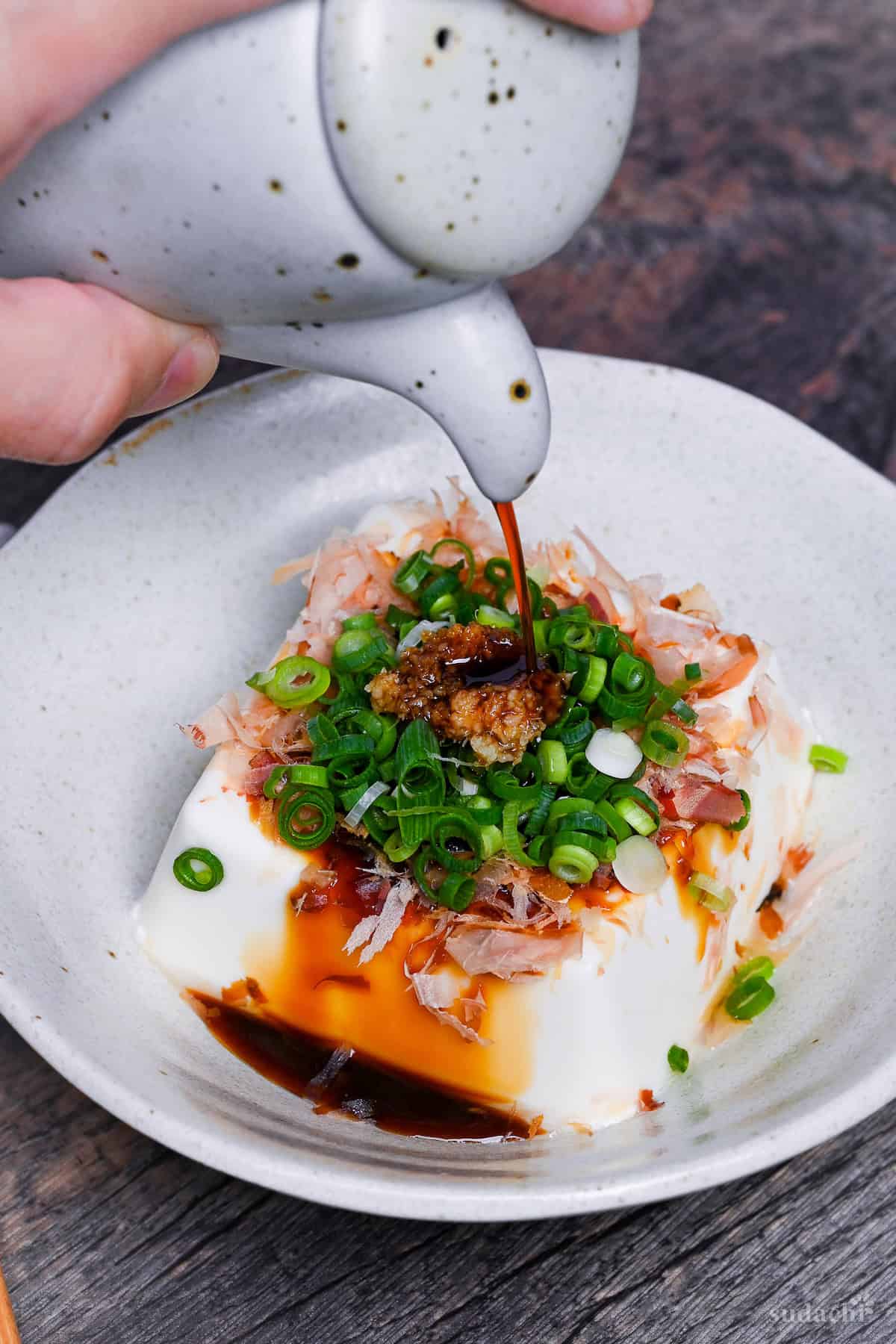
How to Pick the Right Tofu
Not sure whether silken or firm tofu will hit the spot today? Scan the cheat sheet below and pick the block that fits your texture, nutrition, and prep-time needs in seconds.
| Feature | Silken (Kinugoshi) | Cotton/Firm (Momen) |
|---|---|---|
| Texture / Mouthfeel | Extra-smooth, custard-like; slips down the throat | Springy and cohesive; holds its shape |
| Flavor Impact | Light, clean, subtly sweet | Richer, “soy-milk” depth; stands up to bold sauces |
| Best Season & Mood | Hot days, craving a cool, silky bite | When you want something more filling or high-protein |
As you might already know, tofu roughly has 2 main types: silken (絹) and firm (木綿). (And in between this, there are different levels of “firmness,” but that’s another story.) Long story short, there’s no rule of which one to use for hiyayakko.
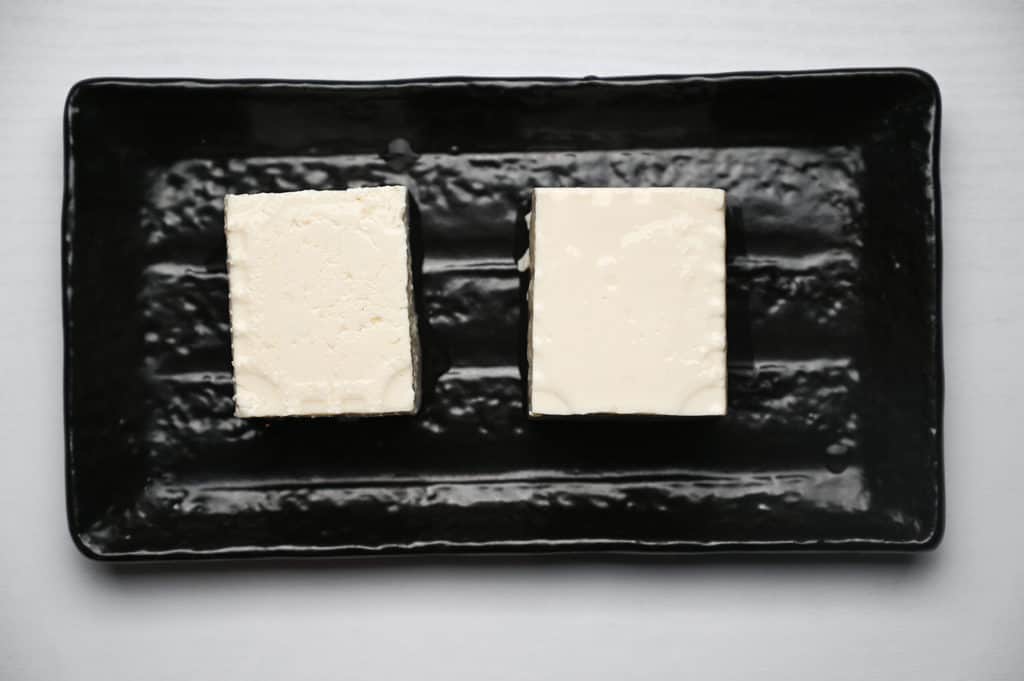
Choose firm tofu for its rich soy flavor or silken tofu for its soft texture, depending on your mood and preference of the day.
I personally prefer to use silken tofu for hiyayakko, and according to a survey conducted by Kafura (2021), 65.6% of Japanese people prefer silken tofu for hiyayakko!
- Buy fresh: same-day or day-old blocks taste best in raw dishes.
- Match toppings: delicate herbs or ponzu pop on silken; chunky add-ins (corn, kimchi) shine on firm.
- Creamy firm hack: blanch 30 s, then chill to soften flavor and texture.
- Still unsure? Grab one of each and taste test at home. Hiyayakko makes comparison effortless.
15 Topping Ideas: Tried Nightly So You Don’t Have To
After testing out a bunch of different combos for weeks, here are the ones that made the cut. For each one, I explain the flavor profile, when to choose it, and which tofu texture will showcase it best!
Classic Trio ★★★★★
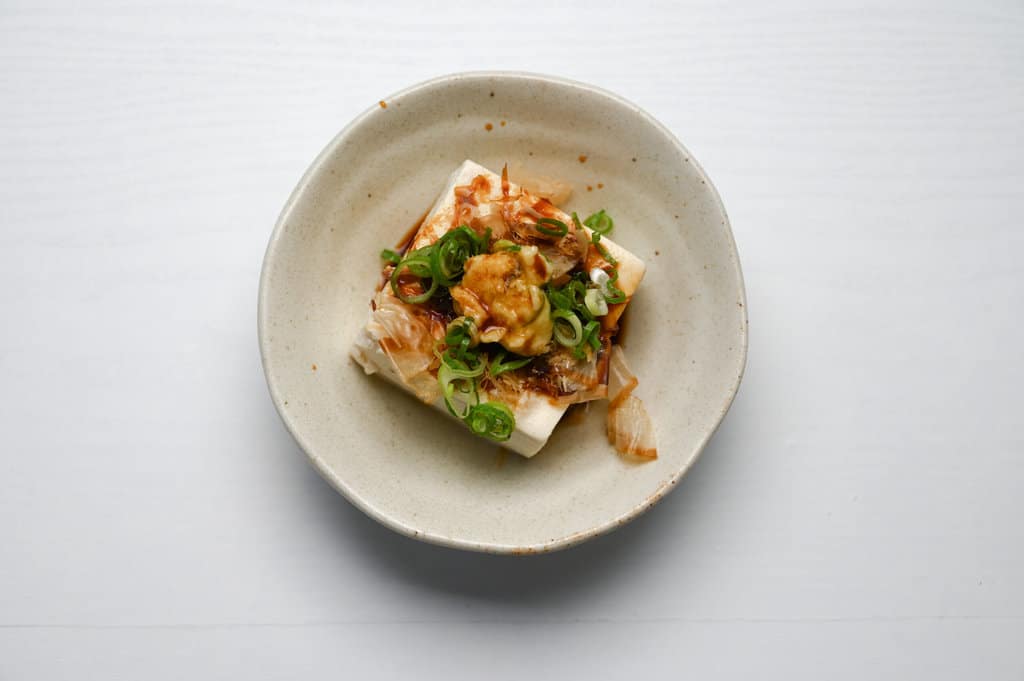
Delicate silken tofu doesn’t need much! Just a hit of fresh ginger heat, scallion crunch, and umami-rich bonito flakes. The soy sauce ties everything together, letting the soybean sweetness peek through while keeping the bite light and cleansing.
When you want the textbook hiyayakko experience, start here.
- Portion: 1 Tbsp bonito flakes + 1 Tbsp chopped scallion + 1 tsp grated ginger; drizzle soy.
- Great For: First-timers or anyone craving the “purest” hiyayakko.
- Best Tofu: Soft Silken for a melt-away finish or Soft Block for a touch more structure.
Tanuki Crunch ★★★★★
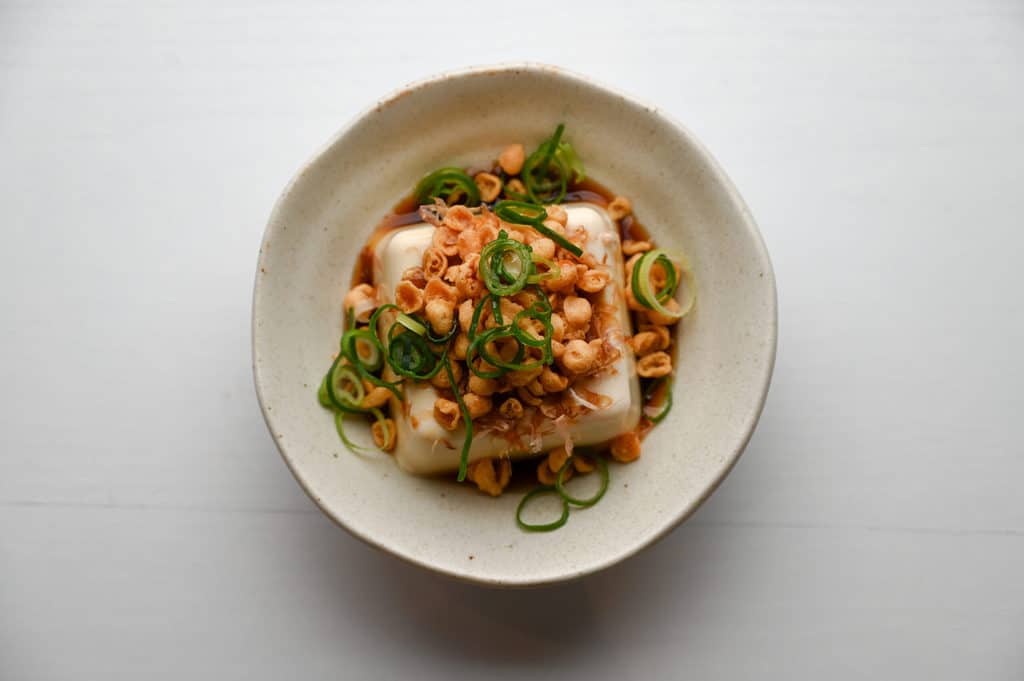
Tenkasu (tempura flakes) act like Japanese croutons, soaking up soy while staying satisfyingly crisp. Their nutty flavor and whisper of oil add depth to the otherwise lean tofu, making this combo feel a bit indulgent without any extra work.
- Portion: 1 to 2 Tbsp tenkasu + 1 Tbsp scallion + 1 tsp bonito; soy or tsuyu.
- Great For: Texture chasers, patio beers, late-night snacking.
- Best Tofu: Soft Silken for contrast; Medium Block if you’re piling it high.
Crispy Onion Shortcut ★★★★★
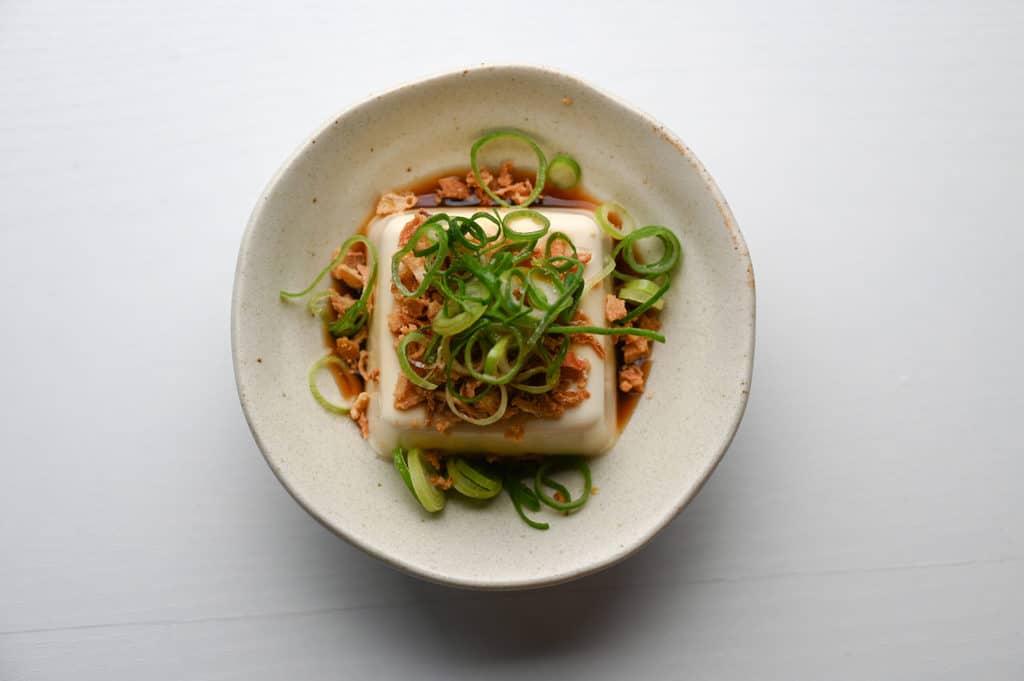
No tenkasu? Store-bought fried onions bring the same crunch with an extra burst of sweet, toasty flavor that echoes diner-style onion rings. Keep a jar next to the spices and you’re always five minutes from dinner.
- Portion: 1 to 2 Tbsp fried onions + 1 Tbsp scallion; soy or tsuyu.
- Great For: Pantry-only nights and family tables.
- Best Tofu: Soft Silken or Soft Block.
Natto Boost ★★★★★
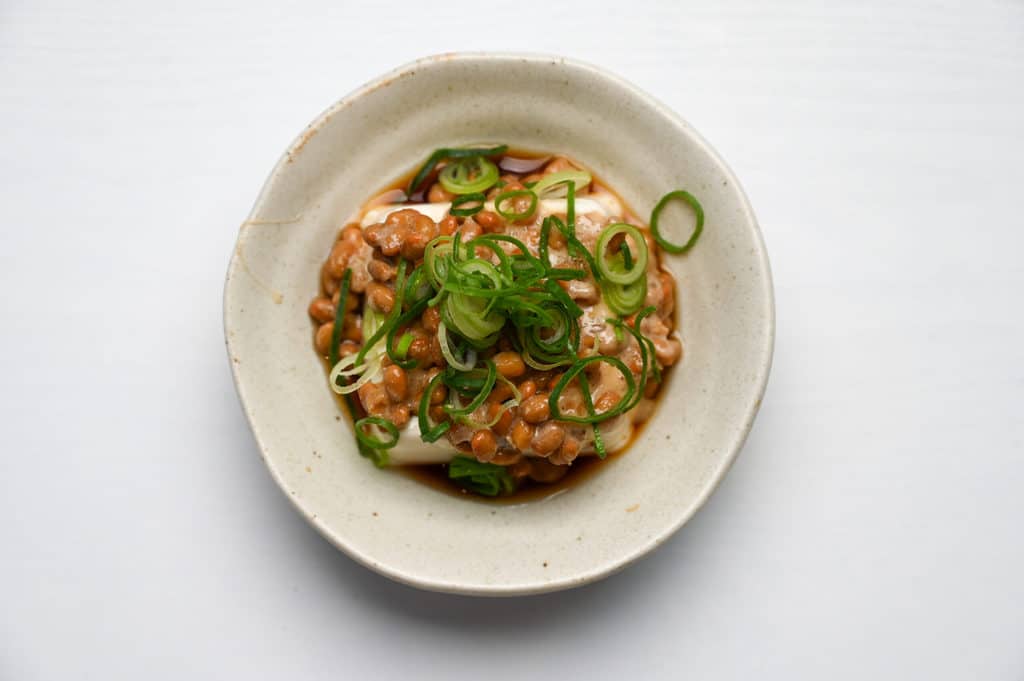
Sticky, fermented natto drapes itself over tofu like a savory sauce, adding earthy depth. The slight funk balances nicely with the tofu’s mildness, while scallions lift the whole bowl with a green bite. If you already like natto on rice, this cooler version will feel like second nature.
- Portion: 1 natto pack (including sauces) + ½ Tbsp scallion.
- Great For: Fermentation fans and gut-health enthusiasts.
- Best Tofu: Medium Block or Firm Silken so the beans don’t slide off.
Kimchi & Korean Seaweed ★★★★★
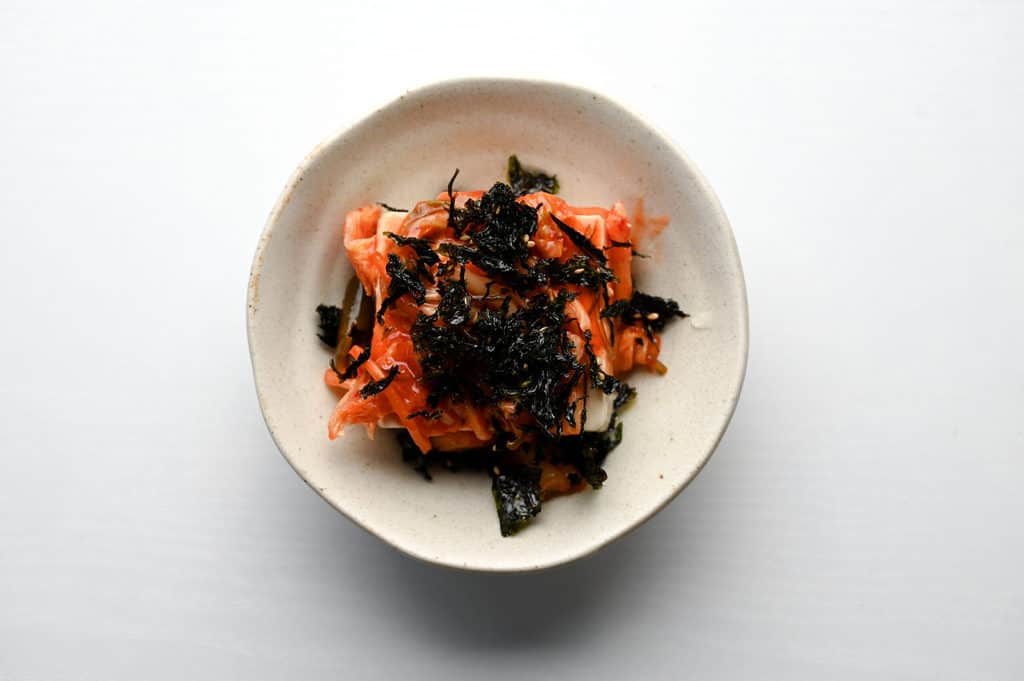
The bright acidity and slow burn of kimchi slice straight through tofu’s creaminess, turning each mouthful into a mini palate-reset. Roasted seaweed adds crunch plus ocean umami, echoing the flavors you’d find in Korean tofu soups, just chilled.
- Portion: 3 Tbsp kimchi + 1 Tbsp shredded Korean seaweed.
- Great For: Spice seekers and Korean flavor lovers.
- Best Tofu: Medium Block (holds juicy kimchi) or Firm Silken for a softer spoonful.
Miso Chicken Soboro ★★★★☆
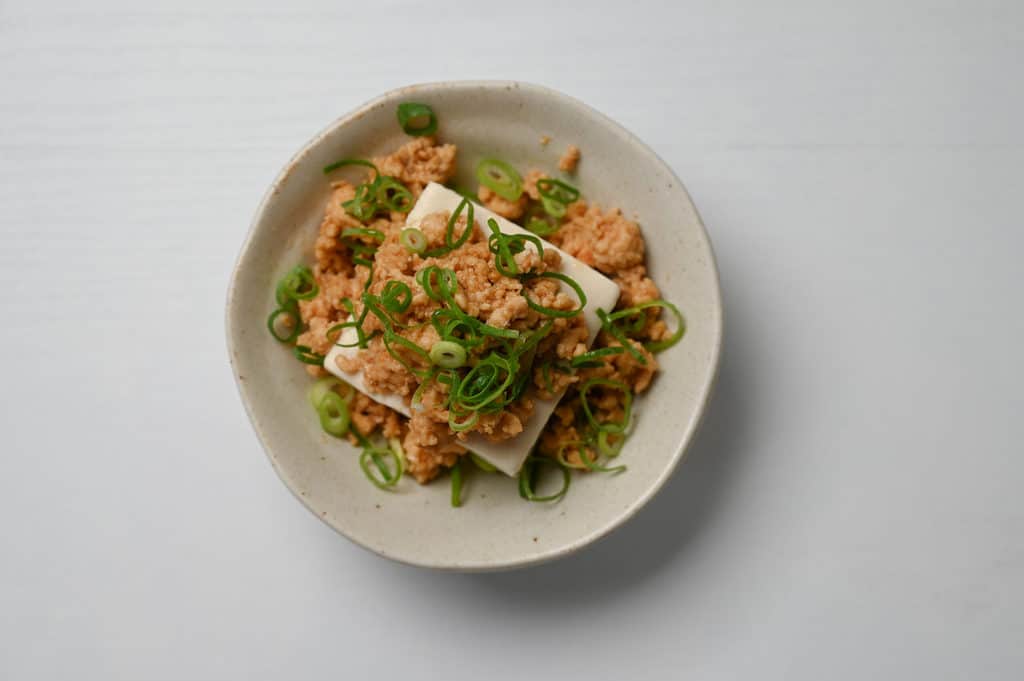
This is more of a meal like hiyayakko with cooked ground chicken meat! I already have recipes for flavored mince meat, so you can refer to one! One is from Soba Noodle Salad with Summer Vegetables, and the other is from Chicken “Sanshoku Soboro Don” Rice Bowl. In the picture above, I used the miso-flavored chicken mince from my soba noodle salad recipe.
- Portion: 2 to 3 Tbsp warm miso chicken mixture.
- Great For: Protein boosts and meal-prep lunches.
- Best Tofu: Soft Block
Chili-Sesame Tobanjan ★★★★☆
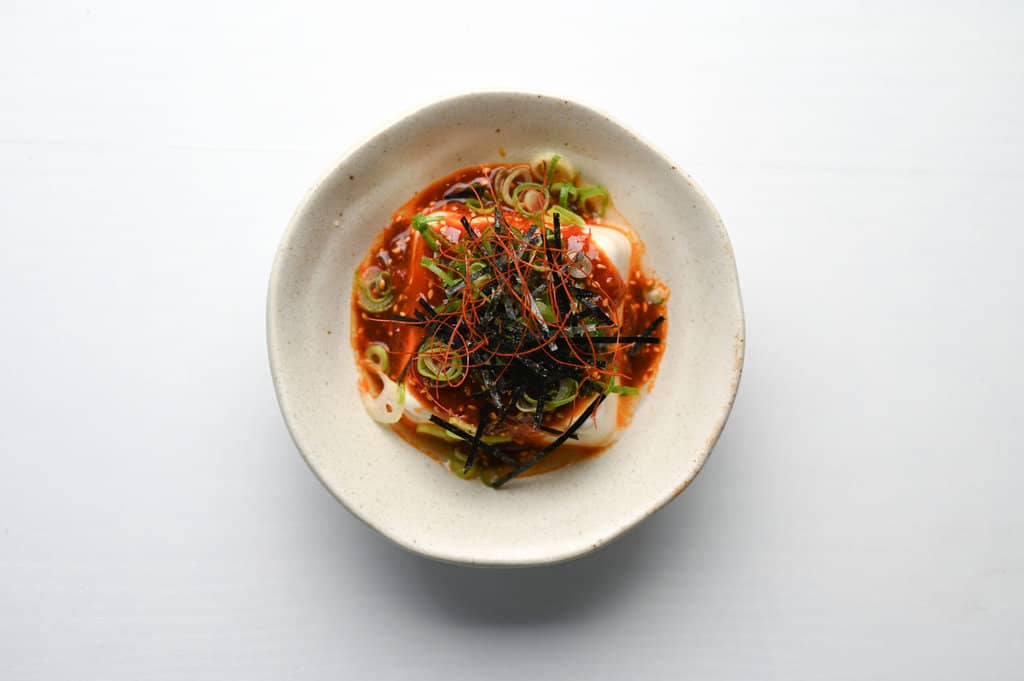
A spoonful of tobanjan (fermented chili bean paste) mixed with sesame oil, soy, honey, and seeds becomes a glossy, spicy-nutty drizzle. The heat wakes up cold tofu, while the sesame adds toasted depth and crunch.
- Portion: ½ Tbsp tobanjan + ½ Tbsp sesame oil + 1 tsp soy + 1 tsp sesame seeds + ½ tsp honey; garnish with scallion, nori, chili threads.
- Great For: Spicy food lovers ready for the next level.
- Best Tofu: Soft Silken if you like it silky; Firm Silken for tidy cubes.
Salad-Chicken ★★★★☆
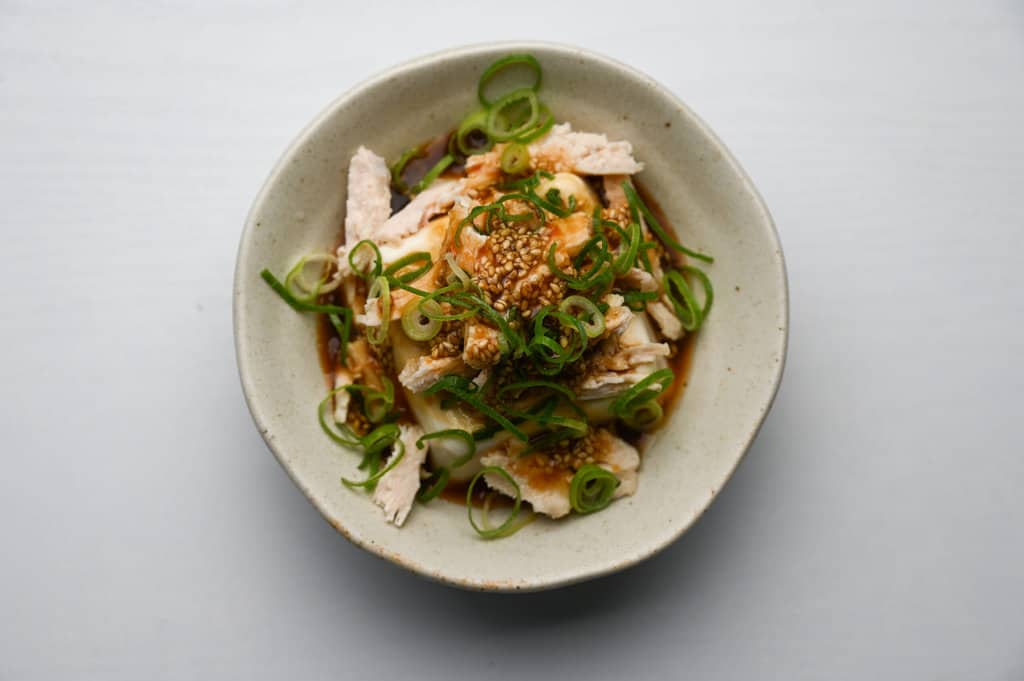
Slices of poached “salad chicken” (a Japanese meal-prep staple) give tofu a lean, meaty counterpoint. The lightly seasoned poaching broth doubles as a savory dressing, and the combo keeps you full without feeling heavy. My recipe for salad chicken and the sauce can be found here.
- Portion: Your chosen amount of sliced salad chicken + a spoon of its poaching sauce + scallion.
- Great For: Gym days, high-protein quick meals.
- Best Tofu: Firm Block or Extra-Firm Block.
Shirasu (Whitebait) ★★★★☆
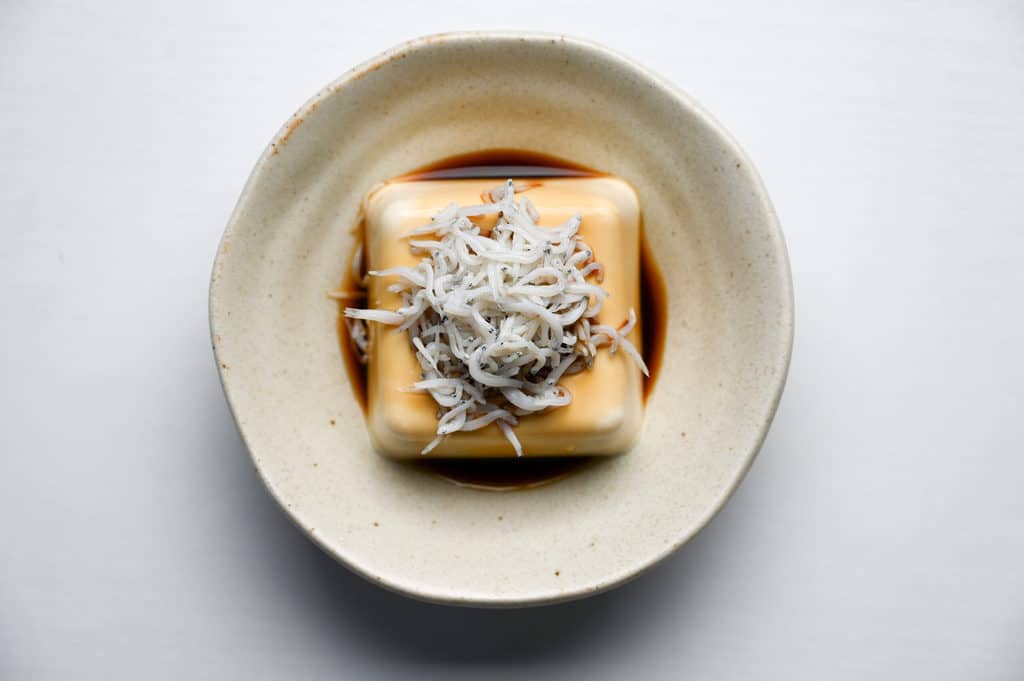
Boiled whitebait scatter across tofu like tiny salty pearls, bringing seafood brine, soft chew, and plenty of bone-friendly calcium.
- Portion: 2 to 3 Tbsp shirasu; splash soy.
- Great For: Shirasu fans.
- Best Tofu: Soft Silken or Soft Block.
Ume-Shiso Zing ★★★★☆
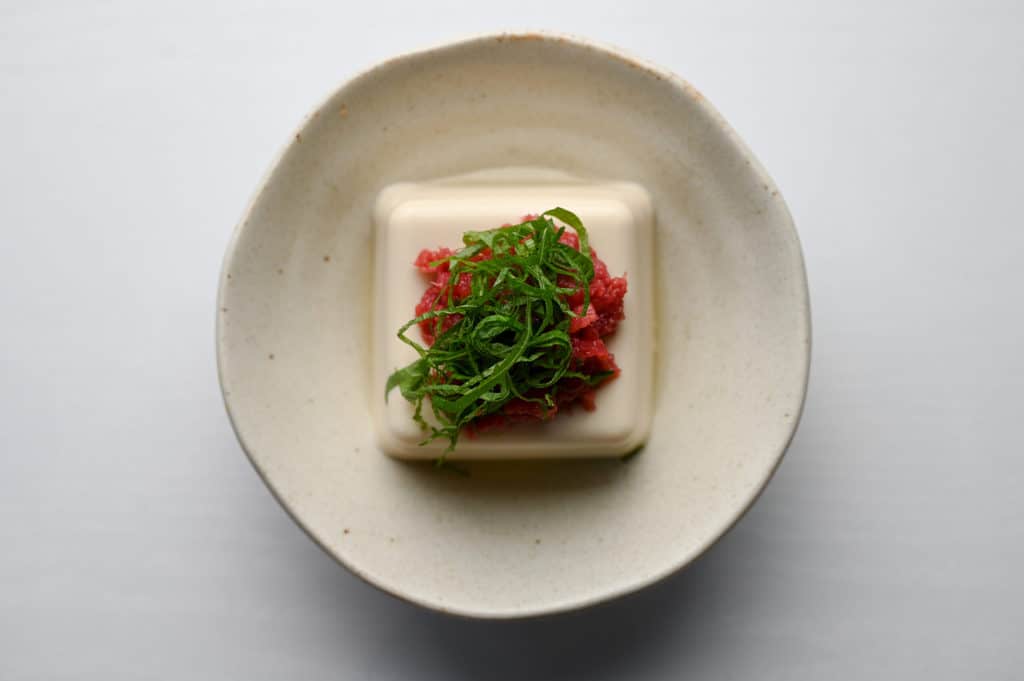
Mashed pickled plum delivers sharp, fruity acidity that cuts through summer heat, while shredded shiso leaves layer in mint-meets-basil aromatics. Together, they turn tofu into a cooling palate cleanser that pairs beautifully with grilled meats or rich noodle dishes.
- Portion: 1 to 2 mashed umeboshi + 2 sliced shiso leaves.
- Great For: Sour-flavor lovers, side dishes for rich mains.
- Best Tofu: Soft Silken.
Grated Daikon Refresh ★★★★☆
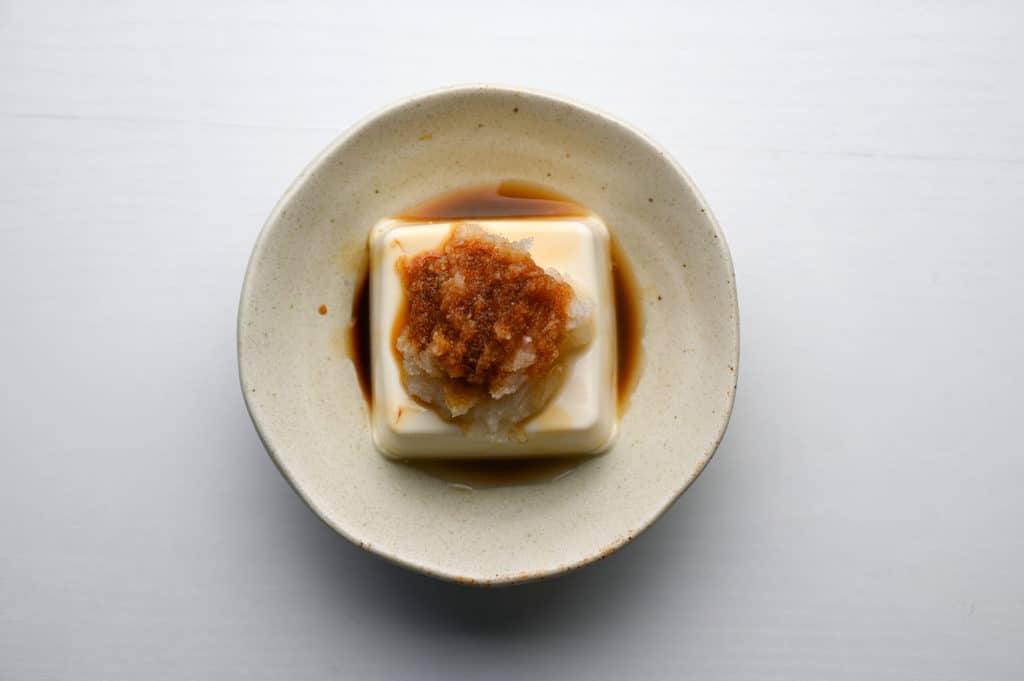
Freshly grated daikon mingles with soy to create a chilly, slightly peppery sauce that keeps every bite light. The high water content amplifies tofu’s cooling effect, making this combo the edible equivalent of plunging your face into a cold stream.
- Portion: 1 Tbsp grated daikon; soy to taste.
- Great For: Heat-wave lunches.
- Best Tofu: Soft Silken or Soft Block.
Kimchi & Egg Yolk ★★★★☆
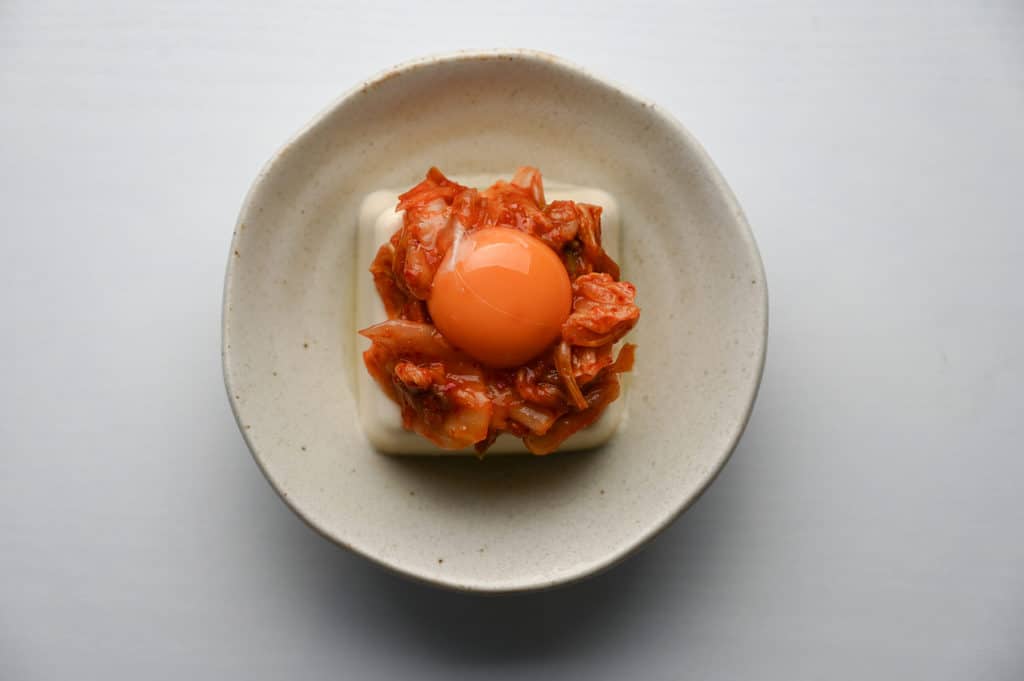
A raw, pasteurized egg yolk melts into the kimchi’s spicy juices, forming a creamy orange sauce that clings to tofu. The extra richness tames the chile heat and turns the dish into legitimate comfort food.
- Portion: 1 pasteurized egg yolk + 2 to 3 Tbsp kimchi.
- Great For: Late-night cravings, spicy-but-comforting bowls.
- Best Tofu: Soft Block or Firm Silken.
Avocado-Wasabi Mash ★★★★☆
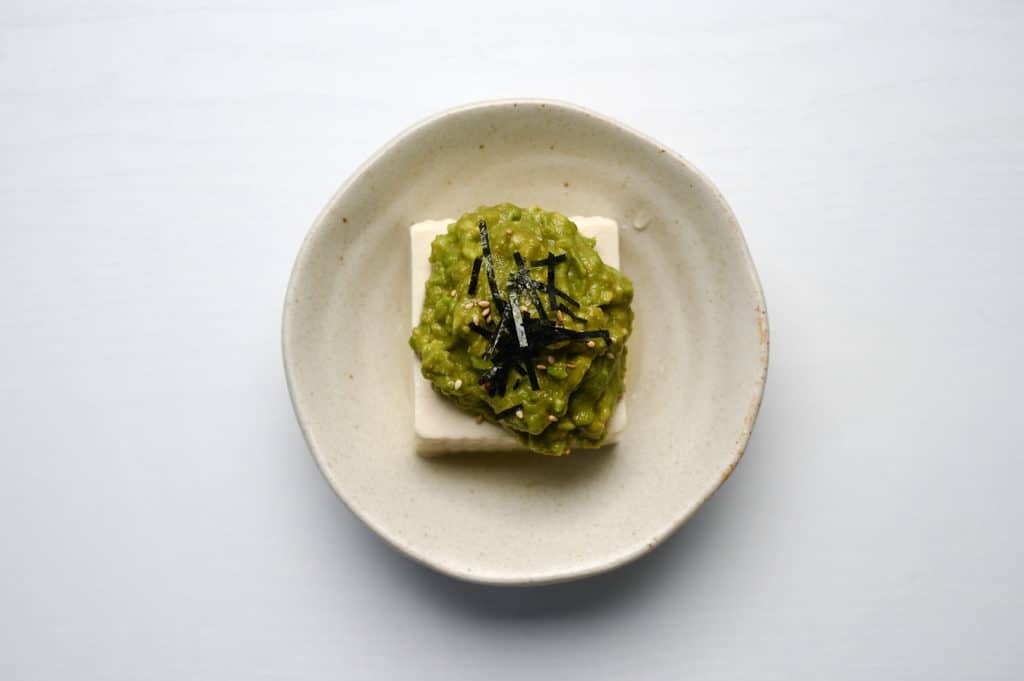
Mashed avocado blankets tofu with buttery richness, while a dab of wasabi delivers a clean, nose-tingling kick. Sesame seeds and nori boost the sushi vibe even more.
- Portion: ½ mashed avocado + 1 tsp soy + ¼ to ½ tsp wasabi; sesame & nori optional.
- Great For: Healthy-fat seekers, plant-based eaters.
- Best Tofu: Soft Block or Firm Silken.
Mentaiko-Cream Cheese ★★★☆☆
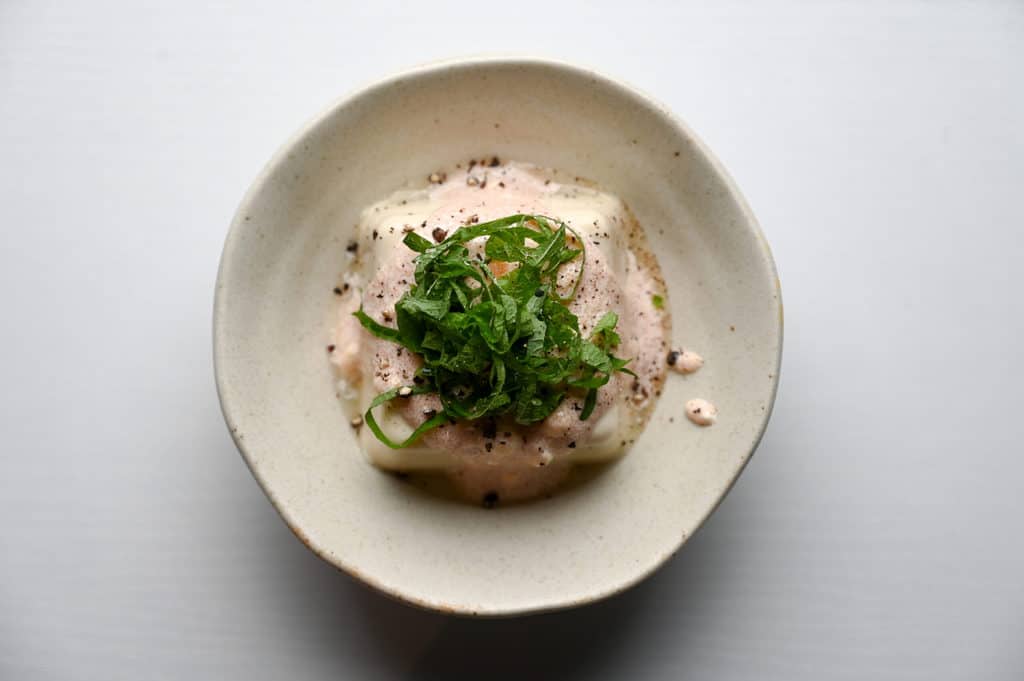
Spicy cod roe and tangy cream cheese fuse into a luscious spread that echoes Japanese izakaya appetizers. The richness begs for a sturdier tofu, while ooba (perilla) leaves and black pepper cut the creaminess so it never feels heavy.
- Portion: 25 g mentaiko + 1 Tbsp cream cheese + 1 tsp milk + 2 ooba leaves + pinch pepper.
- Great For: Indulgent snackers, date-night small plates.
- Best Tofu: Firm Silken.
Tuna-Wasabi ★★★☆☆
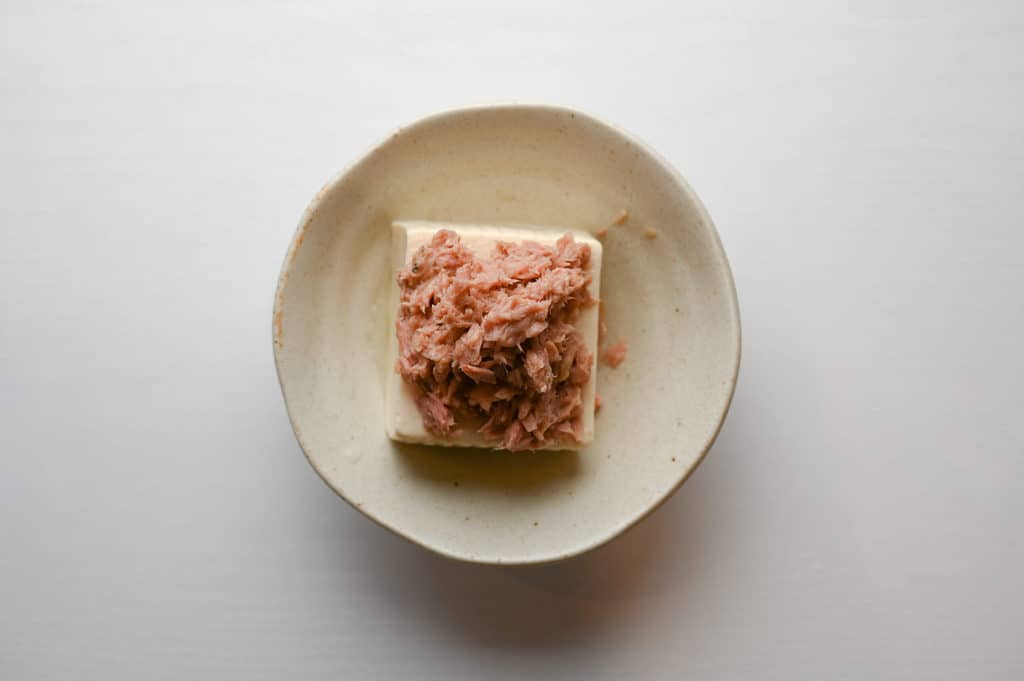
Canned tuna gets an instant sashimi makeover with soy and wasabi, creating a briny, mildly spicy topping that comes entirely from the pantry. Stir before spooning so the tuna stays juicy.
- Portion: 50 g canned tuna + 1 tsp soy + ½ tsp wasabi (more for heat).
- Great For: Zero-shopping days, college-dorm kitchens.
- Best Tofu: Firm Block or Extra-Firm Block.
Essential Tips & Tricks
- Use the freshest tofu you can find! Flavor drops off sharply even one day after purchase.
- Decide on texture first: choose silken for a creamy mouthfeel, firm for a richer, meatier bite.
- Lightly wrap the block in paper towel for 10 min to drain surface water; avoids watery flavor.
- Season only at the very end; soy sauce left to sit pulls water out and dilutes flavor.
- Drizzle soy sauce sparingly. Start with a few drops per bite and add as needed.
- Grate ginger right before serving; volatile oils fade within minutes.
- Keep toppings to roughly one-quarter of the tofu’s volume so the bean flavor stays center-stage.
- If the block feels too firm, dip it in 80 °C water for 30 seconds, chill quickly, then plate.
- Wipe any pooling liquid from the plate rim with a folded paper towel before serving.
With these simple tips in mind, you’re set for success every time you make Hiyayakko.
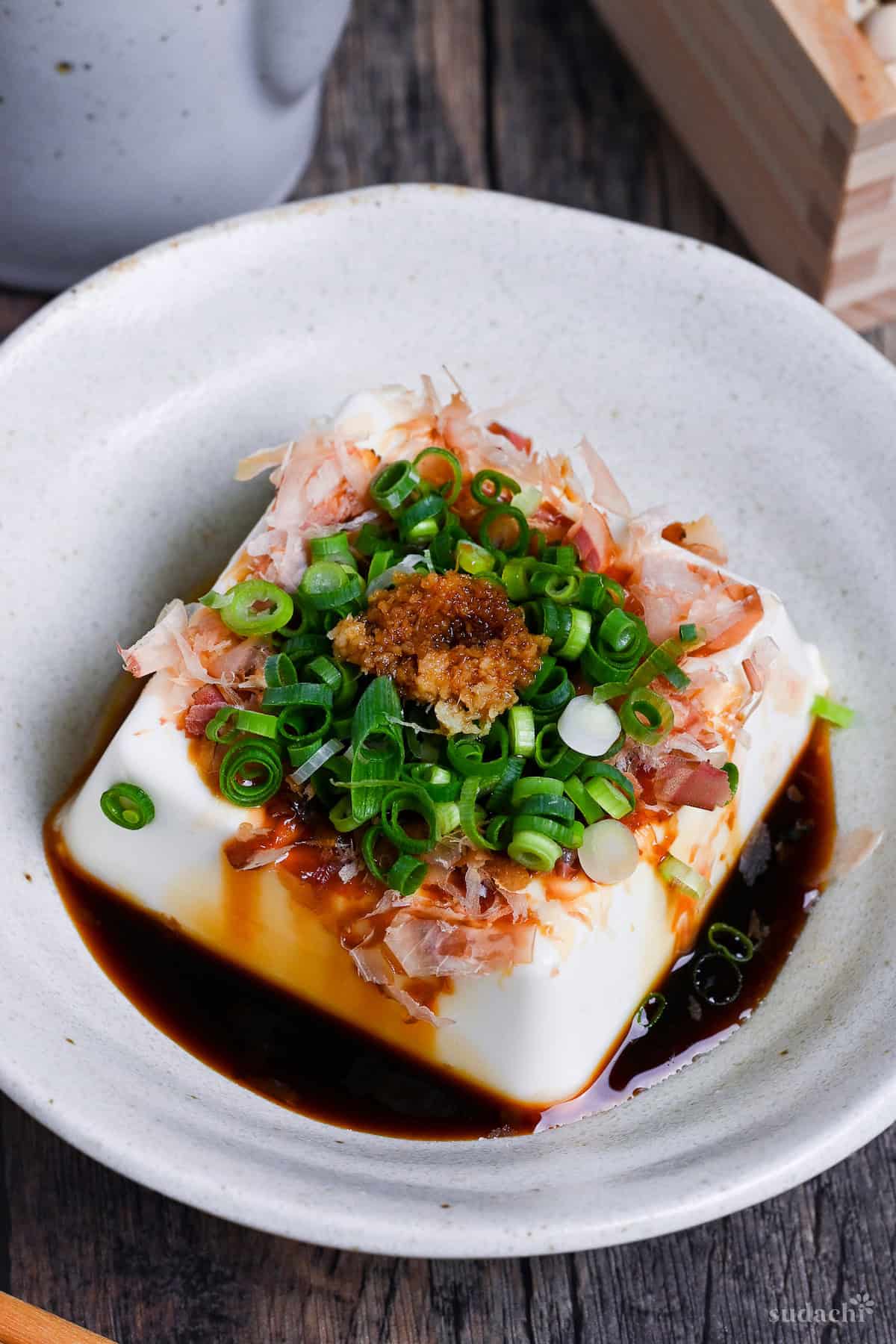
Serving Suggestions
FAQ
Here are answers to frequently asked questions I have received across all platforms, including here, YouTube, Instagram, and Pinterest. If you have any questions, feel free to send them to me anytime! It will be a big help for everyone in this community!
“Soft” or any package that says silken ≈ 絹ごし (kinu). “Firm/extra-firm” ≈ 木綿 (momen). If a block wiggles like pudding it will eat like silken; if it keeps sharp edges when you squeeze the pack it behaves like cotton.
Pressing longer than 10 min for hiyayakko trades juiciness for density. Beyond 20 to 30 min the mouthfeel becomes crumbly like feta and the surface cracks. Save heavy pressing for grilled or fried recipes.
Knife drag is the culprit. Use a long, thin, very sharp chef’s knife and push straight down in one motion. Wetting the blade helps it glide without tearing.
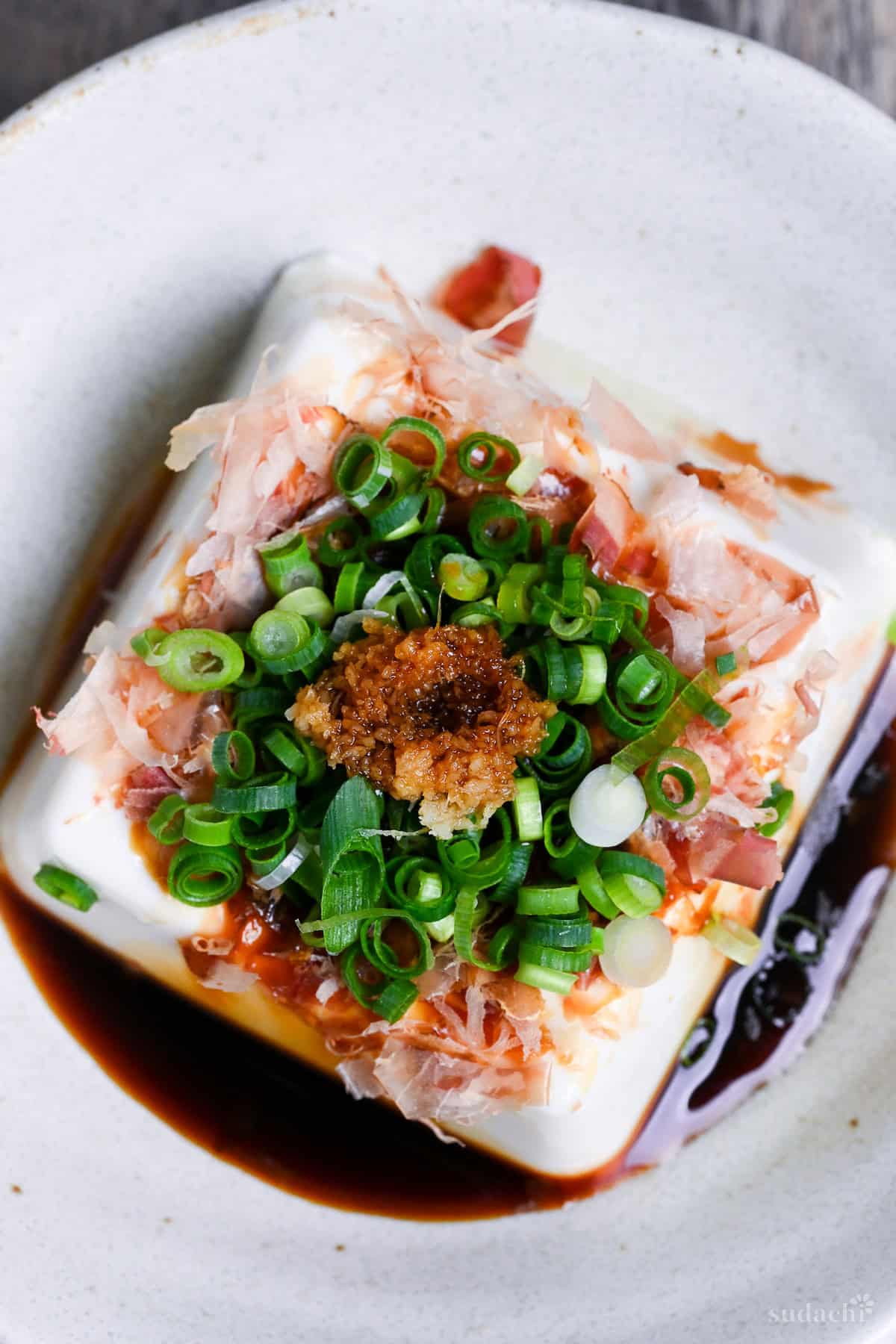
I hope you enjoy this Hiyayakko article! If you try it out, I’d really appreciate it if you could spare a moment to let me know what you thought by giving a review and star rating in the comments below. It’s also helpful to share any adjustments you made to the recipe with our other readers. Thank you!
More Japanese Tofu Recipes
- Teriyaki Tofu Donburi (Vegan Rice Bowl)
- Japanese Style Mapo Tofu (Mabo Dofu)
- Agedashi Tofu (Japanese Deep Fried Tofu)
- Pan Fried Tofu Steak with Japanese Sauce (vegan)
Hungry for more? Explore my tofu recipe collection to find your next favorite dishes!
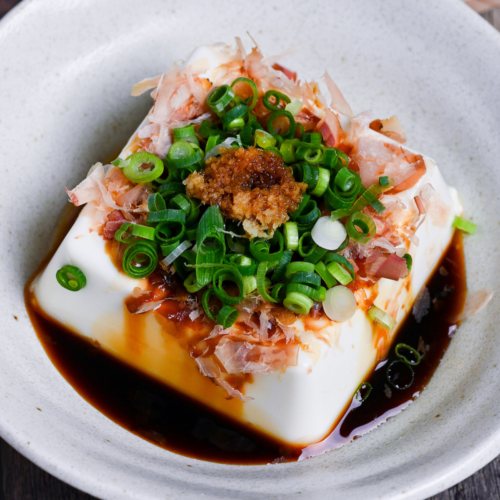
Hiyayakko Japanese Cold Tofu (with 15 Topping Ideas)
Ingredients
- 150 g tofu use fresh; silken = creamy, firm = rich
Toppings in picture:
- 1 tbsp bonito flakes (katsuobushi)
- 1 tbsp finely chopped green onions
- 1 tsp ginger root grated
- 1 drizzle Japanese soy sauce (koikuchi shoyu)
- toppings of your choice see in post for ideas
My recommended brands of ingredients and seasonings can be found in my Japanese pantry guide.
Can’t find certain Japanese ingredients? See my substitution guide here.
Instructions
- Peel the film off of the packaging of the tofu and drain the liquid. Wrap the tofu with a few sheets of kitchen paper and rest for 5-10 minutes in the refrigerator to absorb the excess moisture.

- Remove the kitchen paper and place the block of tofu onto a serving plate. (If you're using a large block of tofu you can cut it into halves or quarters for multiple servings.)

- Add your desired toppings.

- Enjoy!

Video
Notes
- Slice with one clean, downward push of a wet, sharp knife; never saw.
- Grate ginger just before plating; its aromatic oils fade within minutes.
- Drizzle soy sauce only at the table! Start with ½ tsp and add to taste.
- Keep total toppings under 25 % of the tofu’s volume.





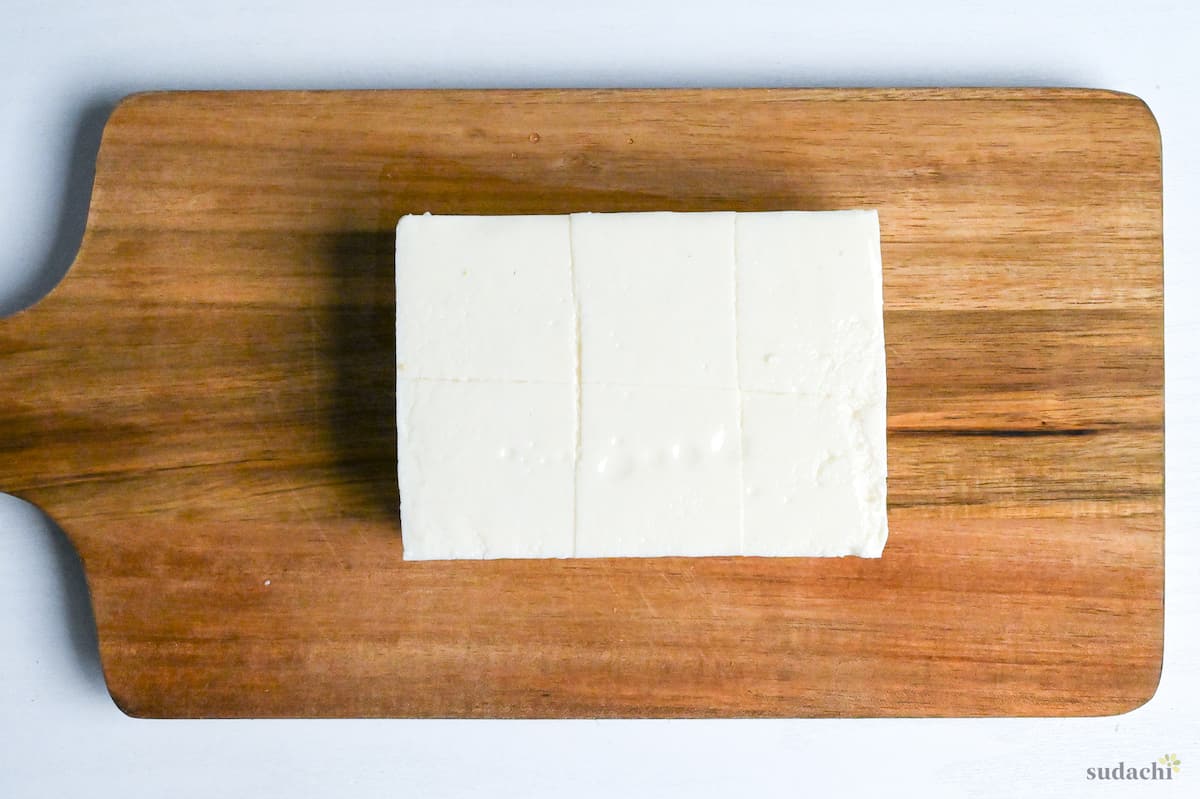
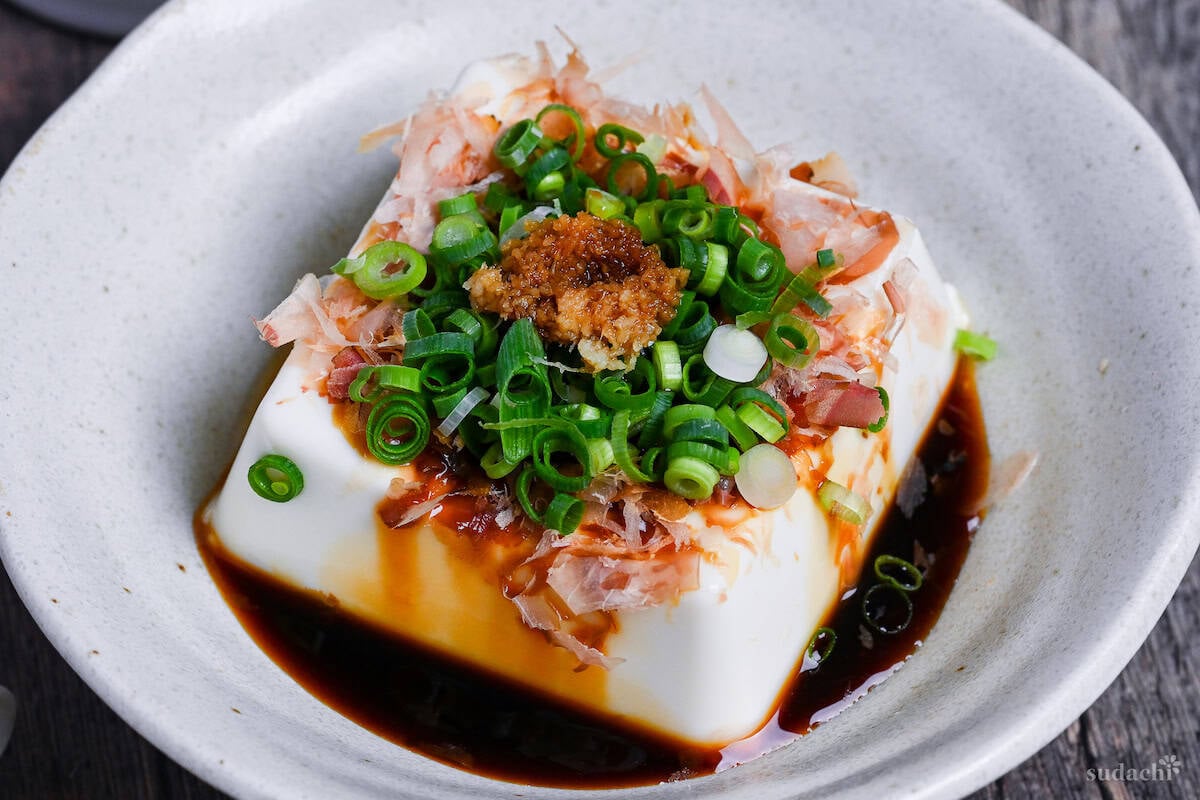
Good morning (for us!) Yuto!
We were enjoying a traditional hiyayakko for breakfast and I wondered if you had a post on it. Silly question! We never have strayed from the traditional katsuobushi green onion version but you just opened up a whole new world of possibilities! Once again you have improved our lives, much appreciated!
Good morning, John!
I’m so happy to hear that this article was helpful and gave you some fresh inspirations! Hiyayakko is such a simple dish, but exploring new toppings can really freshen things up. Excited for what you’ll try next! 🙂
Yuto